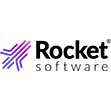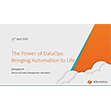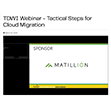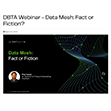
Getting to the Heart of Governance for Today’s Data-Driven Business

(spritekiku/Shutterstock)
The phrase “big data” is probably the understatement of the century. Data today isn’t just big, it’s overwhelming. Studies show that 90% of the world’s data was created in just the past two years. If today your data seems big – wait until your organization starts drinking from the Internet of Things firehose. The flood of information keeps growing.
Simultaneously, so do the challenges of keeping this vast amount of data timely, accurate and trustworthy. Organizations can’t afford the risk of losing control over and access to reliable and trustworthy data. This is particularly critical considering the competitive pressures of meeting customer expectations and looming regulatory and legislative deadlines.
Still, most businesses approach data governance from the wrong angle. So many times, the conversation revolves around technical, system-oriented challenges and procedures instead of the business case. And it’s no surprise IT saves the day by implementing data warehousing and data management tools that provide some metadata and technical data lineage capabilities. But in reality, these tools are just quick (and limited) fixes that address only the immediate needs of the organization. If the business wants to be data-driven, what you really need is a business capability to make sense of data.
The current fragmented approach involves integrating systems and moving data based on requirements and analysis of sources and targets — as opposed to establishing rules, standards and policies around how the data will be used by the business users within different departments. In addition, IT typically records their findings and designs in a flurry of archaic paper documents that detail how the data will be moved and how frequently (daily vs. hourly vs. real time), quality thresholds that need to be respected, which rules need to be checked, and more. After analysis and design, the solution needs to be implemented and someone in IT builds the code. Finally, the solution is tested before it goes into production. At each of these points the organization knows exactly where the data came from and how it moves between systems.
But what happens later, when there are new requests for specific information, such as a bank or healthcare organization scrambling to meet a new regulatory deadline? The staff who worked on the original project may have moved on, or the documentation of the design is misplaced, or worse, completely missing. Trying to go back into your businesses’ multiple databases and reconstruct where information has come from and whose hands have touched it after it’s been created is a time-consuming, expensive, and imperfect process. It’s like your basement is flooded, and now you’re down there with a mop to try to clean up the mess. Throwing more IT man- and technology power – essentially a bigger mop — at a data cleanup project isn’t going to help.

(Tashatuvango/Shutterstock)
The better approach is to proactively stop the water from flooding the basement in the first place. This can be accomplished by putting an automated and systematic control process in place right from the start, or formalizing the process already in place by integrating the business case with IT interaction.
This much-needed, technology-enabled approach to data governance takes an enterprise-wide, sophisticated and systematic approach to handling data, where many user groups are involved across the organization to ensure the availability, usability, integrity and security of the data, critical for businesses leveraging big data as an asset and staying in line with regulatory compliance demands. And most important, data governance creates an agreed upon, collaborative and executable framework, or operating model, for determining enterprise-wide policies, business rules and assets for the data governance team (including the chief data officer, stewardship committee and working groups) and business users to follow.
Adopting an operating model of policies and standards for governing data goes beyond IT’s paper-based trail of data movement between systems, and at a much larger scale, helps determine data inventory, data ownership, critical data elements (CDE), data quality, information security, data lineage and data retention. It’s through this operating model, including data lineage, where critical insights can be gained and any user, at any moment, can see where each piece of data has come from, which users have interacted with it, where it’s going, and what other databases it will feed into.
Here are five important points to keep in mind when putting your data governance policies in place to ensure significant impact from your initiative:
- Technical metadata (i.e., columns, tables, processes, repositories)alone is not enough to help a DBA or data steward understand and model the data in a way that allows efficient data management. A semantic layer needs to be built on top of the metadata to offer meaning to the data for proper data modeling and better data performance. This is why it’s essential for data governance to be an integrated process, with the business side of the organization working hand-in-hand with IT.
- Lineage of data from source to target systems along with transformations, as well as to business metadata like business term definitions and rules, is critical to data stewards and for technical purposes. However, traceability, or a 360 degree view on data assets, is essential for business users looking to answer questions like “Where does my data come from? What policies were used? What standards are applied?” For instance, policy managers will want to see the impact of their security policy on the different data domains, ideally before they enforce the policy; analysts want to have a high level overview of where the data comes from, what systems and what rules were applied; and an auditor might want to see a trace of a data issue to the impacted systems and business processes. Traceability is essential to get the more insightful answers that straight lineage alone can’t provide.
- Use true enablingartifacts such as mapping specifications and data sharing agreements to proactively drive the process. By driving the movement of data from the business needs you create transparency and control. SLAs included in the data sharing agreements establish clear ownership and accountability between data producers and consumers, which is a cornerstone of trust and agility.
- Create system sensors: control points that scan the data source and target systems when something has changed, and automatically notify data stewards when an issue is identified. By alerting the data team of any changes made to the system gives data stewards and others in the organization time to react to the changes, either by making adjustments to rules and standards for governing the data, and/or to avoid a larger issue from occurring in data performance. The business can now deal with data exceptions, rather than having to deal with exceptions as the business.
- Implement a data governance platform that not only smoothly integrates the landscape of surrounding tools and techniques, but is scalable and adaptable to quickly meet the evolving needs of a business. This will help reduce operational costs and ensure a laser focus on data quality, while also eliminating the need to rely on IT to scramble for answers when it comes to data requests and exceptions.
Data governance isn’t only about risk management. It’s about getting to the heart of your data and making it easier for everyone in the organization to use and trust the data for business advantage. A good data governance system will not only proactively prevent problems, but will make it easier for users throughout your company to look at your data in a more intuitive, understandable way. Data governance is a framework for setting data-usage policies and implementing controls designed to ensure that information remains accurate, consistent and accessible in a consistent and timely manner so your company is in the driver’s seat to capitalize on the many opportunities made available through big data.
About the author: Stan Christiaens is Co-founder and Chief Technology Officer of data governance software developer Collibra.
Related Items:
Bridging the Trust Gap in Data Analytics
This Catalog Recommends Data with Machine Learning
Why Integration and Governance Are Critical for Data Lake Success
September 18, 2025
- EDB Research Shows 87% of Enterprises Lag in Sovereign AI Adoption
- Zencoder Brings AI Coding to a Billion Users with Universal AI Development Platform
- PingCAP Brings Global Data Leaders Together for TiDB SCaiLE 2025 in California
- Qlik Connect 2026 Set for April 13–15 in Florida
- Domo Selected by Showpass to Deliver Scalable, Real-Time Embedded Analytics Worldwide
- Databricks Launches AI Accelerator Program to Scale the Next Generation of AI Startups
- Kennesaw State Researchers Tackling AI-Generated Fraud to Protect Data Integrity
- Salesforce Deepens Commitment to UK AI Innovation, Increases Investment to $6B
September 17, 2025
- Dynatrace Joins GitHub MCP Registry to Accelerate AI-Powered Developer Innovation
- LogicMonitor Sets New Standard for AI-First Observability with Edwin AI and Expanded Service Intelligence
- NASA Expands Access to Earth Data Through New Metadata Pipelines
- MongoDB Extends Search and Vector Search Capabilities to Self-Managed Offerings
- Gartner Says Worldwide AI Spending Will Total $1.5T in 2025
- Cohesity Extends Cyber Resilience Leadership with New Security Innovations and Partnerships
- Ataccama Opens Registration for FWRD 2025
September 16, 2025
- MongoDB Launches AI-Powered Application Modernization Platform to Reduce Technical Debt and Speed Innovation
- UC San Diego Plays Key Role in National Effort to Build a Fusion Research Data Platform
- NVIDIA Welcomes Data Guardians Network to Its Elite Startup Program
- Acceldata Survey Finds Persistent Gaps in Enterprise AI Data Readiness
- Exabeam and DataBahn Partner to Accelerate AI-Powered Security Operations with Smarter Threat Detection
- Inside Sibyl, Google’s Massively Parallel Machine Learning Platform
- What Are Reasoning Models and Why You Should Care
- Rethinking Risk: The Role of Selective Retrieval in Data Lake Strategies
- The AI Beatings Will Continue Until Data Improves
- Software-Defined Storage: Your Hidden Superpower for AI, Data Modernization Success
- Top-Down or Bottom-Up Data Model Design: Which is Best?
- Beyond Words: Battle for Semantic Layer Supremacy Heats Up
- In Order to Scale AI with Confidence, Enterprise CTOs Must Unlock the Value of Unstructured Data
- What Is MosaicML, and Why Is Databricks Buying It For $1.3B?
- How to Make Data Work for What’s Next
- More Features…
- Mathematica Helps Crack Zodiac Killer’s Code
- GigaOm Rates the Object Stores
- Promethium Wants to Make Self Service Data Work at AI Scale
- Databricks Now Worth $100B. Will It Reach $1T?
- Solidigm Celebrates World’s Largest SSD with ‘122 Day’
- AI Hype Cycle: Gartner Charts the Rise of Agents, ModelOps, Synthetic Data, and AI Engineering
- Data Prep Still Dominates Data Scientists’ Time, Survey Finds
- MIT Report Flags 95% GenAI Failure Rate, But Critics Say It Oversimplifies
- The Top Five Data Labeling Firms According to Everest Group
- Career Notes for August 2025
- More News In Brief…
- Seagate Unveils IronWolf Pro 24TB Hard Drive for SMBs and Enterprises
- Gartner Predicts 40% of Generative AI Solutions Will Be Multimodal By 2027
- DataSnap Expands with AI-Enabled Embedded Analytics to Accelerate Growth for Modern Businesses
- Acceldata Announces General Availability of Agentic Data Management
- Qlik Announces Canada Cloud Region to Empower Data Sovereignty and AI Innovation
- Transcend Expands ‘Do Not Train’ and Deep Deletion to Power Responsible AI at Scale for B2B AI Companies
- Pecan AI Brings Explainable AI Forecasting Directly to Business Teams
- Databricks Surpasses $4B Revenue Run-Rate, Exceeding $1B AI Revenue Run-Rate
- SETI Institute Awards Davie Postdoctoral Fellowship for AI/ML-Driven Exoplanet Discovery
- Deloitte Survey Finds AI Use and Tech Investments Top Priorities for Private Companies in 2024
- More This Just In…






































